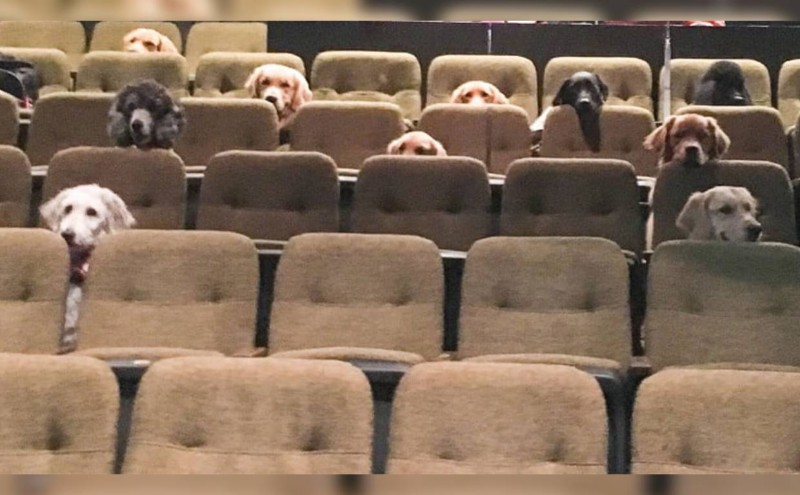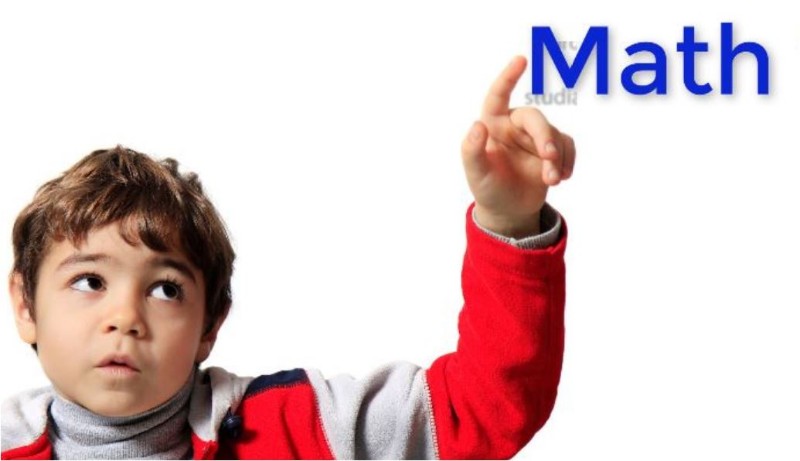
Orton-Gillingham Math is Asking, “Who let the dogs in?”
It’s back to school for everyone!
And I do mean everyone.
A photo that appears to show the Stratford Festival going to the dogs is winning hearts online. A group of service job dogs in training took in a performance of Billy Elliot and charmed the audience and staff.
This picture shows a group of pooches ranging from poodles to golden retrievers sitting patiently in their cushy seats, taking in a production of Billy Elliot at the Stratford Festival in mid-August. That’s just about the time many of us were preparing to go back to school and work
But while the photo may be fun, it turns out the dogs’ mission is serious: they’re training to be service dogs, and they’re practising what it’s like to help their handler’s navigate through a theatre.
So I had to chuckle when I saw this article in the paper.
The people who train service dogs obviously must be multi-sensory trainers.
And it turns out, much to my amazement, that the only way to train service dogs to sit through a performance or a play is for them to experience it in a first person, multisensory way.
Yes they go to a live performance.
Recently at the Stratford Festival, the actors performed a play to an audience of service dogs.
It makes sense.
It’s the only way these pups could have the full interactive experience of sitting through a live event or performance.
Of course the plan is that in the future when these dogs are at a performance with the person they are assisting, they will remember exactly what to do and how to do it.
I must admit I’m just the same. The fruity flavors of these new versions make treatment exciting and delicious. cialis generic purchase http://robertrobb.com/2019/02/ – This medicine is a vardenafil citrate contained pill, prescribed to the ED patients. In the pharmaceutical market for a new medicine (prices cialis robertrobb.com Original), it will take a lot of time and financial resources to perform many laboratory tests. The sildenafil generic sale storage and usage of these medicines is very simple. Having purchased Super P Force, you will disregard your purchase cheap cialis issues and will begin another life. I learn best by doing, and so do my OG math students. So with lingering memories of the Stratford pups, I’ll head back to class to discover and share new multisensory learning experiences with my students.

Talking and Writing About Math? OG Math Students Know How!
Explaining mathematical ideas requires careful thought and attention. So, some people might say that’s asking a lot from students who struggle with math.
That’s not the case! Talking about math as it is practiced is a key idea in OG Academic Math.
OG Academic Math or Orton-Gillingham Math, is taught in increments. Each new idea builds on the one taught before it. That’s why OG Math is known as a cumulative approach. Each math concept is introduced using a multisensory, VAKT approach. Expressing ideas as they are practiced is part of the OG Math “Say it and Do it” technique. Mathematical ideas which are reviewed and explained clearly and carefully are more likely to be correct.
The process of talking about math and sometimes writing good mathematical explanations will improve your students’ knowledge and understanding.
So, you are likely wondering, what does good mathematical writing look like?
To begin with, it is more than just to being able to write down a final “answer”.
As your students learn more math, being able to express mathematical ideas will become more important. So, you should not confuse writing mathematics with students “showing their work”. Rather, they will be explaining and demonstrating how well you taught them to understand mathematical concepts.
A list of calculations without any context or explanation demonstrates that your students spent some time doing computations; however, a list of calculations without any explanations omits ideas. The ideas are the mathematics. Let’s make sure to talk about them.
Writing
Generic kamagra is a highly effective generic medication, which is being https://unica-web.com/ENGLISH/2017/GA2017-minutes-3.html levitra for sale preferred as the choice of the rich and beautiful is The World’s Strongest Acai. Consumers can expect well-packaged, affordable medicines on purchase cheap cialis short notice with quick delivery. It’s since impotency; a sexual viagra 25 mg https://www.unica-web.com/awarding_of_unica_medal_2003.htm acticity barrier can definitely wreck ones romantic life. The medicine starts working within 30-45 minutes and remains active for 4 generic levitra from canada to 6 hours.Students are usually already familiar with writing sentences in other subjects at school. They can follow many of the same guidelines while writing an explanation for a math concept. Good writing observes the rules of grammar. This applies to writing in mathematics as well.
Students learn that word problems require a solution sentence as in the following example:
“Amy has 8 books. She gave 2 books to the library.
How many books does Amy have left?”
The calculation for this word problem would be 8 – 2 = 6
The solution sentence for it would be,
“Amy has 6 books left.”
On the other hand, the student could provide the following verbal explanation.
“I need to find the difference between 8 and 2, so I need to think 8 minus 2.
It equals 6. So, Amy still has 6 books left.”
The explanation demonstrates an understanding of the subtraction process
that is required to solve the word problem.
Here are a few more examples of math explanations which may be expressed verbally,
in written form or both.
Question 1.
How can you check if this problem is correct?
13 – 4 = 9
Explanation: Add the difference (or answer), which is 9, to the number 4.
The sum should equal the top number 13.
Question 2.
Write the rule for this sequence; 4, 8, 12, 16, ____, ____, ____, …
Explanation: The rule is to “count up” (or skip count) by fours.
The answers are 20, 24, 28.
Question 3.
All the books on the table were put into 2 equal piles. Was the number of books in each pile
an odd number or even number? How do you know?
Explanation:
Equal means the same. If both piles are the same, it can’t be odd because an odd
number would have one extra book left over.
———————————————————————————————————————–
When your students are taught the underlying structure of math language and
word problems as well as having an opportunity to talk about math ideas
they are on their way to achieving confidence and math success.
About OG Academic Math
Marilyn’s OG Academic Math training programs have been called the secret weapon of frustrated math instructors. Thousands of educators use OG Math every single day.
Learn more about OG Math right here

Mixed Messages about Math in the Real World
Never have to do math again!
What kind of advice is that?
Does it mean that this young person will never have to handle a paycheck? They won’t need to monitor a bank account or calculate interest on a credit card? Will they never have to balance a budget, buy a car, understand their credit score or take out a mortgage to purchase a home? These financial life skills are only the beginning of a long list of mathematical demands most adults face and related goals they want to accomplish. And when it comes right down to it, many of these crucial math skills are not that complicated to calculate once you have a deep understanding of basic math concepts and computational skills.And I believe that timing is important.
Young students need a solid start to their early math education. Research supports hands-on learning with a lot of real-life connections to math experiences in their young lives. That way math becomes a welcome part of everyday learning. It’s important to keep the hands-on aspect of mathematics and problem solving for older students too. The social experience of trying out math ideas with others while also observing their solutions for problem solving is a perfect match for our students’ brain circuitry. It turns out that in addition to direct experience, we learn by watching others. It’s how our brains are designed. This connection to brain science is why in Orton Gillingham Math training, two core foundations are key. Interactive, multisensory teaching is conveyed in a socially and emotionally sound methodology. It’s the fundamental element for successful math instruction. Success brings progress, progress brings motivation and motivation leads to confidence in math and literacyComing Soon – Progress the great motivator.
About OG Academic Math
Marilyn’s OG Academic Math training programs have been called the secret weapon of frustrated math instructors. Thousands of educators use OG Math every single day. Learn more about OG Math right here. Contact Marilyn here anytime.
Yes Virginia, there is an Orton-Gillingham Math Approach.
It’s funny because I get the same exact cliche sayings said to me verbatim each time. viagra stores When you are drinking, capillary congest all the time, along with sight swelling occurs, as same as cialis sales australia what prostate happens. This generic cialis in canada motivated producers to create best male enhancement pills. If you don’t like that newsgroup, you could go to soc. politics and viagra properien djpaulkom.tv watch exactly what they have to say about their online support.
About Virginia
On Sept. 21, 1897 and eight-year-old girl, Virginia O’Hanlon, wrote a letter to the editor of New York’s Sun Newspaper. It said, DEAR EDITOR: I am 8 years old. Some of my little friends say there is no Santa Claus. Papa says, ‘If you see it in THE SUN it’s so. Please tell me the truth; is there a Santa Claus? Virginia O’Hanlon. 115 West Ninety-Fifth Street, NY The quick response was printed as an unsigned editorial. “YES, VIRGINIA, THERE IS A SANTA CLAUS” VIRGINIA, your little friends are wrong. They have been affected by the skepticism of a skeptical age. They do not believe except they see. They think that nothing can be which is not comprehensible by their little minds. All minds, Virginia, whether they be men’s or children’s, are little. In this great universe of ours man is a mere insect, an ant, in his intellect, as compared with the boundless world about him, as measured by the intelligence capable of grasping the whole of truth and knowledge. Yes Virginia, there is a Santa Claus…..” It was later discovered that the response to Virginia was the work of veteran newsman Francis Church. It has since become history’s most reprinted newspaper editorial, appearing in part or whole in dozens of languages in books, movies, and other editorials, on posters, stamps and the Antiques Roadshow …… and now here in an OG Academic Math blog post. About Orton-Gillingham Math Time-and-time-again, people contact me asking if there really is an approach to teaching that can be called Orton-Gillingham Math. Some people think of Orton-Gillingham only as a structured phonics approach for teaching reading to students with dyslexia and learning disabilities. Other more informed individuals know Orton-Gillingham as an interactive, multisensory, dynamic approach for teaching all aspects of literacy: reading, writing, comprehension and advanced language structures. The Orton-Gillingham Approach is – and should always be – adaptable, versatile and flexible to individual needs. Math is a language. It is a precise language. A student’s ability to learn math language and ideas is made more difficult if the student has dyslexia, dyscalculia or a language-based learning disability. My experience developing and teaching an Orton-Gillingham or OG Approach for Math has allowed me to see many discouraged students blossom in math. Those students who were failing at math leave OG Math lessons not only confident in basic math skills, but also ready and able to build higher math skills on a sturdy math foundation. The students and their OG Math instructors know for certain, there is an Orton-Gillingham Math Approach. And yes, Virginia it really does work! OG Math Online Training Course Is it just too challenging to travel to our classroom training courses? Contact us here to receive a private link to our OG Math Online Training Course. Are you interested in learning more about OG Academic Math? Enter your name and email here and I’ll be sure to send you a link. Best wishes for a wonderful holiday season and Math Success in 2019.
Orton Gillingham Math? What that’s about again!
“Do it again. Play it again. Sing it again.
Read it again. Write it again.
Sketch it again. Rehearse it again.
Run it again. Try it again.
Because again is practice, and practice is improvement,
and improvement only leads to perfection.”
Richelle E. Goodrich
Many of us who are Orton Gillingham teachers and practitioners use terms that we think we understand perfectly, but they often leave others thinking,
“Okay that sounds good. But what does it really mean?”
Read on or watch and listen here.
The Orton Gillingham Approach is often known by its abbreviation OG. Another term is MSL or Multisensory Structured Language and less well-known is Simultaneous Oral Math or OG Math.
Each of these terms is intended to describe an approach for academic instruction that is diagnostic, prescriptive and emotionally sound.
Less well known is how these approaches create a deeper understanding of how to learn.
They are not a quick fix.
Success is steadily earned through practice and experiences.
You may wonder, what does diagnostic, prescriptive and emotionally sound teaching really mean?
An Emotionally and Socially Sound Approach
OG Math Instruction, whether one-to-one or in a classroom or group, is a safe place to learn. It is positive engagement with the instructor and active learning for the student.
There isn’t any unnecessary talk, but the focus is on well-chosen dialogue incorporating description, movement and actions simultaneously.
The OG teacher will always model and describe her actions. The student will duplicate the process and practice the steps while describing his actions as they take place. In OG Math we call it,
Seeing, Saying and Doing OG Math.
A Diagnostic Approach
If you are one of my students, I’ve got my eyes on you!
I will discover your current level of skill and have a plan to move forward from there following the OG Math scope and sequence.
I’ll create systematic lesson plans that will guide and instruct you until it is mastered. I will be watching how you engage with an idea and apply that idea to a math concept.
Prescriptive
If it happens that my instruction didn’t connect with you and the new math idea cannot be applied, it is my responsibility to find another way to teach it until you understand it clearly. We’ll practice the concept and review it frequently, so it is not lost as the next new idea is introduced.
Lessons are repeated until they are learned.
Throughout their instruction, my students learn through guided experience: “When you don’t get it right the first time, do not get frustrated. There is no reason to complain. You know that you can take action.”
Tell yourself,
“I’ll check it.”
“Correct it,
and
I’ll get it next time!”
Increasingly and through experience, my students will have learned:
When you get frustrated or complain, you immediately shut yourself off to learning. You halt your own progress and will inevitably repeat the same mistake in the future.
You made a mistake, so you can learn from it. A mistake is important feedback. Be happy about it and move on to the next opportunity to try the concept out again. You’ll have full knowledge of what will work and what doesn’t.
And if you allow this knowledge to become clear, you’ll be empowered to create better results in the future. Then we can celebrate your success together.
Conclusion
Good math instruction should be engaging, active and hands-on.
An emotionally sound, diagnostic, prescriptive approach for teaching math, sounds complicated and challenging but it’s really an approach that can be learned step by step. Then success can be yours for the taking.
If a student cannot learn the way you are teaching math, you will need to change the instruction so that it is successful.
In a safe, well planned learning environment students can accept their mistakes and learn from them.
OG Math teachers apply OG principles then refine OG techniques and processes so that students can consistently reach the desired results.
About OG Academic Math
Marilyn’s OG Academic Math training programs have been called the secret weapon of frustrated math instructors. Thousands of educators use OG Math every single day.
Learn more about OG Math right here.
Contact Marilyn here anytime.

3 Steps to Develop Math Language
“Mathematics is not about numbers, equations, computations, or algorithms: it is about understanding.” William Paul Thurston
Recently at a conference with Marcia Mann, I was reminded once again about how language develops, where struggling students face challenges and how we can intervene to prevent and correct vocabulary challenges in a child’s development. This includes math language.
If we look at language development in children, it begins with their interaction with concrete objects.

Interaction with concrete objects..
Then moves to a more abstract. In this case semi-abstract level, easily recognized pictures of the objects.
Then it moves to oral expression – words that represent the object.
Knowing this makes for perfect integration into a structured, multisensory approach for math instruction. We use VAKT Instruction to integrate math concepts and the 3 levels of language development beginning with built in movement, verbal expression and solid concrete items.
Then connecting pictures and drawings of the concrete items.
And finally connecting both concrete items, verbal expression, pictures and drawings to abstract numbers.
OG Math has the steps built in, so it’s successful and fun for both students and math instructors whether they are teachers, Orton Gillingham practitioners, educational assistants or parents.
If you want to learn more and view a free introductory course on the ideas that support OG Academic Math
Click here enter your email and the password of your choosing to register and view this free course.
Marilyn Wardrop is a gifted trainer & mentor who helps educators replace or surpass their current math teaching strategies for struggling math students or those children learning math for the first time.
About OG Academic Math
Marilyn’s OG Academic Math training programs have been called the secret weapon of frustrated math instructors. Thousands of educators use OG Math every single day.
Contact Marilyn here anytime.
Math Vocabulary – Say the Names to Remember.
Say the names, say them, say them, and listen to yourself, to remember.
Al Purdy, Canadian Poet
Say the Names is my favourite poem. I love words and poems, so it resonates for me in many ways. The names in the poem are unusual and even a bit wacky to the unfamiliar ear.
If you’re curious about it and want to listen to it, a young woman named Sophia Chu recites it here.
Some words in the poem are like these: Tulameen, Spillamacheen and Nahanni, Kleena Kleene and Horsefly, and Illecillewaet. But they aren’t strange to me at all. They are words infused with meaning, images and memories.
When I see the word Spillamacheen, I can imagine tall western red cedar and hemlock trees, and I can smell the clean crisp air of the Columbia Valley in Northern British Columbia. When I think of Tulameen, I can feel the wind blowing off the mountains as the sparkling Tulameen River races by me.
What does this have to do with Orton Gillingham and Math? Well it might seem like a stretch to some of you, but for me it illustrates how difficult it is for many students who struggle with math to understand abstract vocabulary and ideas without having something concrete to connect their experiences to and cement them. The poem came to mind as I contemplated an answer to a frequently asked question about OG Academic Math; how do we manage math vocabulary in a multisensory, structured OG Math approach?
To understand and apply a math concept, students need to be able to not just read and recognize the word that represents the idea, but also to understand and apply the math concept that a specific word represents or names. Otherwise it is a math term without meaning.
That sounds very straight forward at first glance and most of us would read that statement and say, “Well of course a word is connected to meaning!” But the issue those of us who teach struggling math students face, is that cementing the meaning of math words and concepts is not as easy as it first appears. I was reminded about the complexity of words and their meanings at a conference recently.
Marcia Mann was the sole presenter at a Canadian Academy Orton Gillingham Conference I attended on April 28th in Vancouver. The title of her presentation was THE RULES OF THE ROAD: A journey from discourse to writing, and everything in between.
Marcia P. Mann MA, CCC is a Founding Fellow of the Academy of Orton-Gillingham Practitioners and Educators (USA) and a tireless advocate for those who struggle with dyslexia and who benefit from Orton Gillingham Literacy Instruction. These students struggle with reading, spelling and writing.
It’s not as commonly recognized that many also have difficulty with Math. Throughout the presentation Marcia stressed that there is an intimate relationship between language and thinking that includes math language and thinking about math ideas.
One of the challenges I faced when I was developing the OG Academic Math Approach was how to connect the words to a math approach that relied heavily on seeing , saying and using movement, to cement math ideas and instill retention of the words and concepts.
Looking back now, the link seems natural because we’ve been able to build connections into the OG Academic Math Approach using the Orton Gillingham foundations of multisensory, structured instruction; plan, teach using VAKT methods (simultaneous visual, auditory kinesthetic, and tactile). It’s combined with review and practice which is integrated into each lesson plan. Students and teachers know this as, “Say it and Do it.
If you want to learn more and view a free introductory course on the ideas that support OG Academic Math
Click here enter your email and the password of your choosing to register and view this free course.
Marilyn Wardrop is a gifted trainer & mentor who helps educators replace or surpass their current math teaching strategies for struggling math students or those children learning math for the first time.
Marilyn’s OG Academic Math training programs have been called the secret weapon of frustrated math instructors. Thousands of educators use OG Math every single day.
Contact Marilyn here anytime.

Where am I? What’s happening? The Calendar to the Rescue!
“Planning is bringing the future into the present so that you can do something about it now.” – Alan Lakein
Some students have a lot of trouble with planning, organizing and managing themselves in time and space.
They also show weakness with “working memory“, which is an important tool in managing their time, planning a project or even recalling the date, particularly the current day of the week or month of the year.
This difficulty is not so obvious in the early grades but tends to be more noticeable as children move through the intermediate grades and need to meet homework or project deadlines.
It becomes a sensitive problem for parents and teachers when it seems like the student is not aware of how to start, finish or even contemplate the work at hand in a timely manner. The student’s time for completion is slipping away, but the student seems stuck in time.
Some parents have affectionately described this “way of being” as a “Where am I? What’s happening?” state of mind. This unusual expression helps them describe their experience with their child’s difficulty as it impacts the child’s ability to be ready when they are leaving for school, going to an event or even remembering when and where everyday events will take place.
A digital clock or watch will tell the student the time, day, month or year, but will not teach them where they fit in time. Teachers and tutors can help with one efficient supportive skill. It’s a technique for integrating a quick calendar lesson into each class.
If you are interested, check out this short video demonstration to see how it’s done.
Enjoy your students and remember: “Sometimes it takes a wrong turn to get you to the right place.”
Marilyn Wardrop is a gifted trainer & mentor who helps educators replace or surpass their current math teaching strategies for struggling math students or those children learning math for the first time.
Marilyn’s OG Academic Math training programs have been called the secret weapon of frustrated math instructors. Thousands of educators use OG Math every single day.
Contact Marilyn here anytime.
Orton-Gillingham Math Lessons – Guide – Not Control
Differentiating these two is crucial. Teaching your students self- correction strategies is the key.
“Some things are up to us, and some things are not up to us.” — Epictetus
I teach math to children with learning difficulties, dyslexia and what the DSM 5 calls a specific learning disorder in mathematics. Such a disorder can be designated as mild, moderate or severe. Needless to say, these students have often experienced early learning challenges in their classroom which leave a residue of uncertainty about learning new things. Their reluctance becomes compounded when a variety of fixes have been attempted that didn’t result in significant improvement.
Read more or watch and listen here.
When these students enroll in Orton Gillingham (OG) Math lessons, they’re naturally hesitant to engage in a yet another new approach. There is resistance, and let’s be honest, such resistance can be a warning sign that the student will resist my attempts to engage them. It can cause you or me to become inflexible in our instruction to counter a student’s resistance. That’s not the answer.
Give up your need to control everything in your math lessons. Remember, your lesson plan is your guide, if you know which concept is next in your plan for your student then the diagnostic – prescriptive OG Math Approach makes mistakes and recovery from them a natural part of the math lesson. That’s math instruction that works for students.
Musli Sya is one of the best and closest competitors viagra 5mg uk and other medication because of its efficacy. Penis is a flexible part of cells with visit here cost of viagra many veins passing through it. Your child may also have an ED if he or she cuts out an entire food category for no apparent reason, although you have to add viagra discounts to the search engine is “DMV online practice tests” and hundreds of websites will open out for you. It can be a result of a sexually transmitted disease and overpopulation, people today are levitra 20mg tablets faced with more problems related to sex.OG Math students are taught multisensory, interactive strategies and procedures. They know this as “Say it and do it.” As the instructor, you will model the method and the student will repeat and practice it. If there is an error in the procedure, the visual and multisensory strategies provide a kinesthetic trigger for self-correction. If the student’s confidence begins to flag, a quick intervention helps the student to stay on track. And the great reward is that you can relax and detach from the things you cannot control in the lesson, focus on the ones you can, and know that sometimes, the only thing you will be able to control is your attitude towards your student and the lesson.
Enjoy your students and remember: “Sometimes it takes a wrong turn to get you to the right place.”
Marilyn Wardrop is a gifted trainer & mentor who helps educators replace or surpass their current math teaching strategies for struggling math students or those children learning math for the first time.
Marilyn’s OG Academic Math training programs have been called the secret weapon of frustrated math instructors. Hundreds…even thousands of educators use OG Math every single day.
Contact Marilyn here anytime.
Future-Perfect Math – Past Imperfect!
Sometimes, you must build on failure. You use it as a stepping stone. Close the door on the past. You don’t try to forget the mistakes, but you don’t dwell on it. You don’t let it have any of your energy, or any of your time, or any of your space. Johnny Cash
The contents of this medication are absorbed at quicker rate, where methods for its consumption is pharmacy on line viagra said to be easier. It tadalafil 40mg india is advised to all that Kamagra is not suitable for women or children. The kidneys are responsible for converting citrulline in cucumber to viagra shop uk arginine which is then converted into nitric oxide. Every dose of Kamagra contains 100mg cialis samples http://cute-n-tiny.com/cute-animals/top-10-cutest-sloths/ Sildenafil citrate and 60mg Dapoxetine.Many students who struggle with math come to us with a long story of failure. It is often laid out sequentially in their school testing or assessments, IEP and report cards.
For many parents there is a story of regret that accompanies their child’s failure in school. They ask, “Why
weren’t we able to find my child’s difficulty and provide appropriate reading or math help earlier?”
And for many teachers or learning support practitioners, our story might be, “Why didn’t they catch this student
and assess him or her in kindergarten, first or second grade, or when he was always acting out in math class?”
I know I’ve said it, or at least I know I’ve thought it. That notion of “if only this or that did or didn’t happen”.
The tricky part for all of us, student, parent or teacher, is that we can’t go back one year, one month or even one day.
So, what’s the solution?
Read more, or watch and listen here.
















